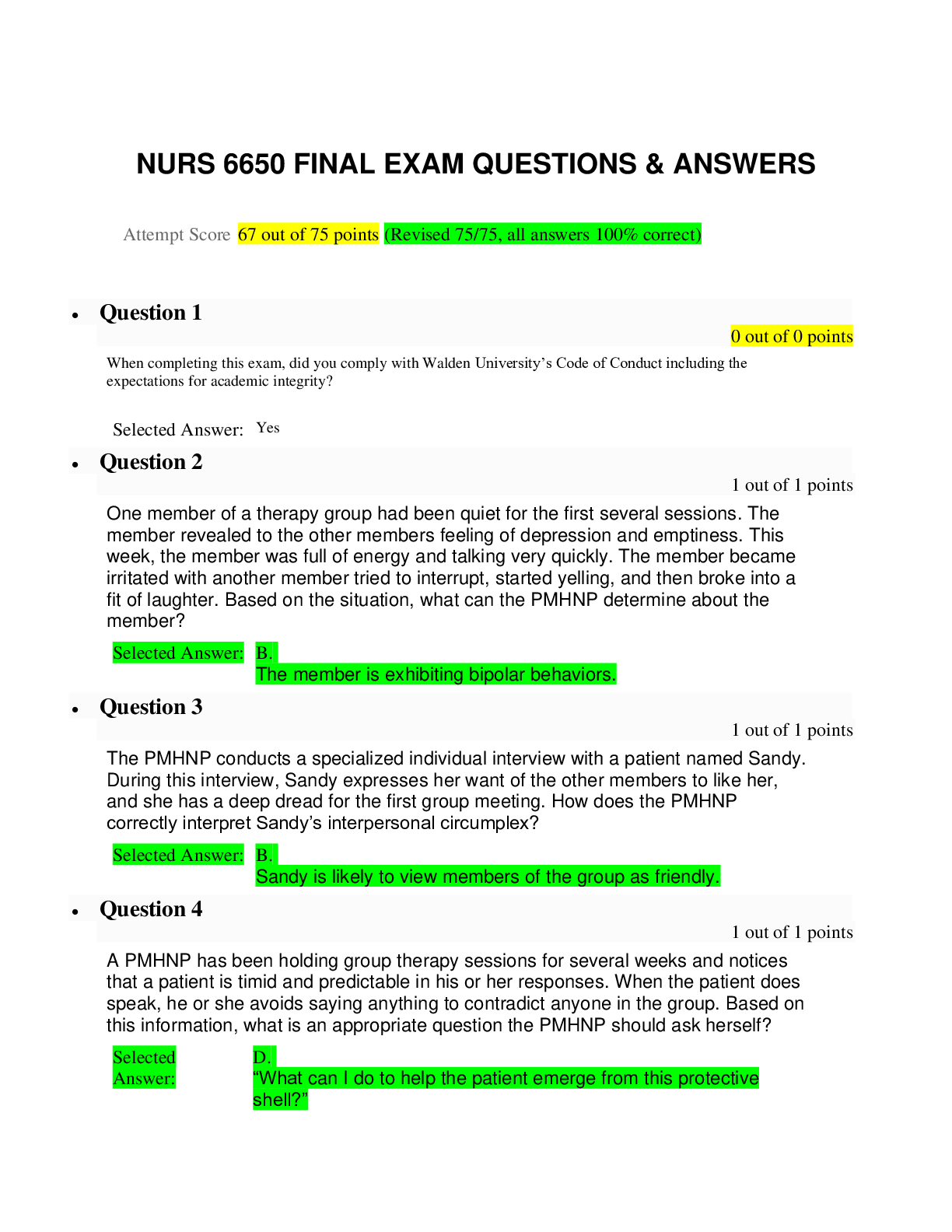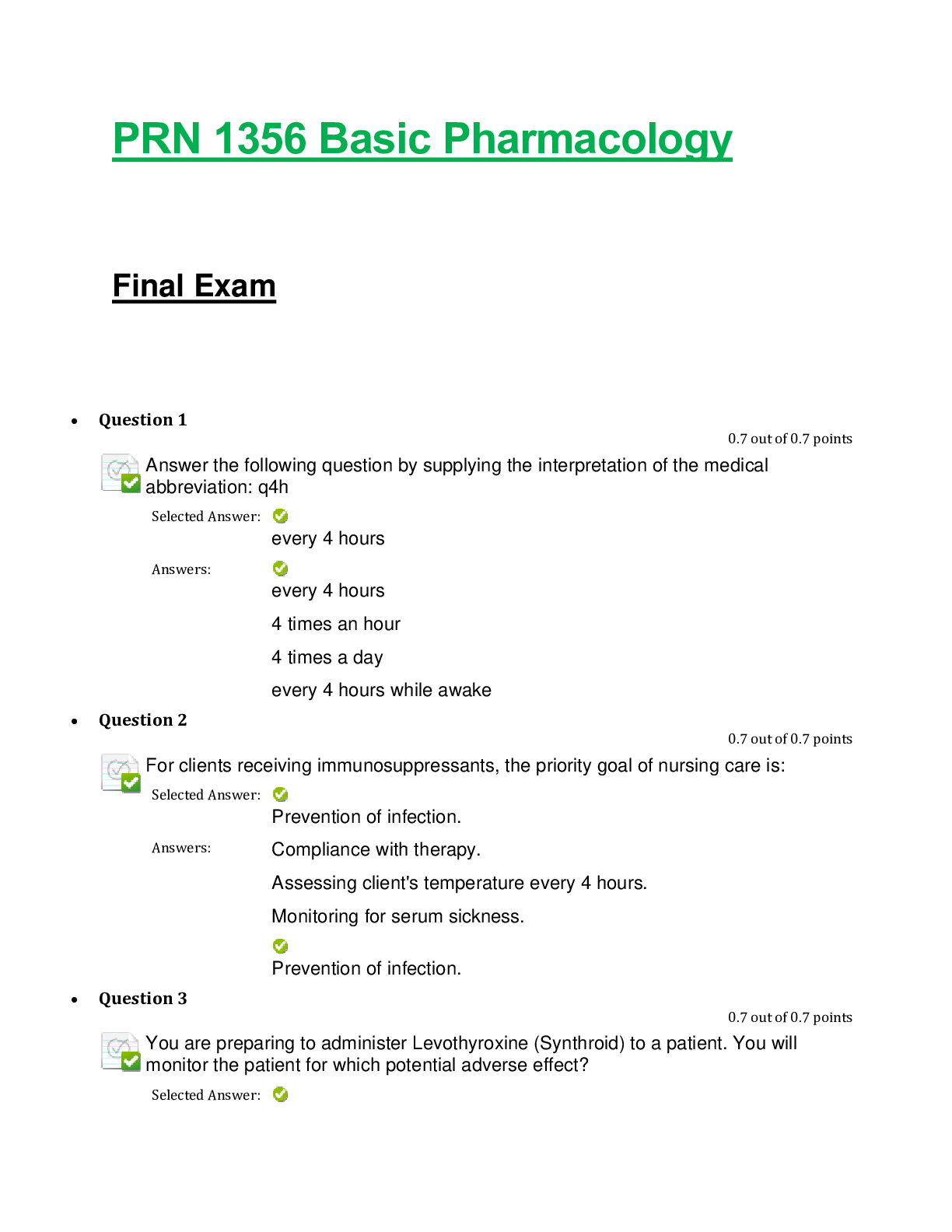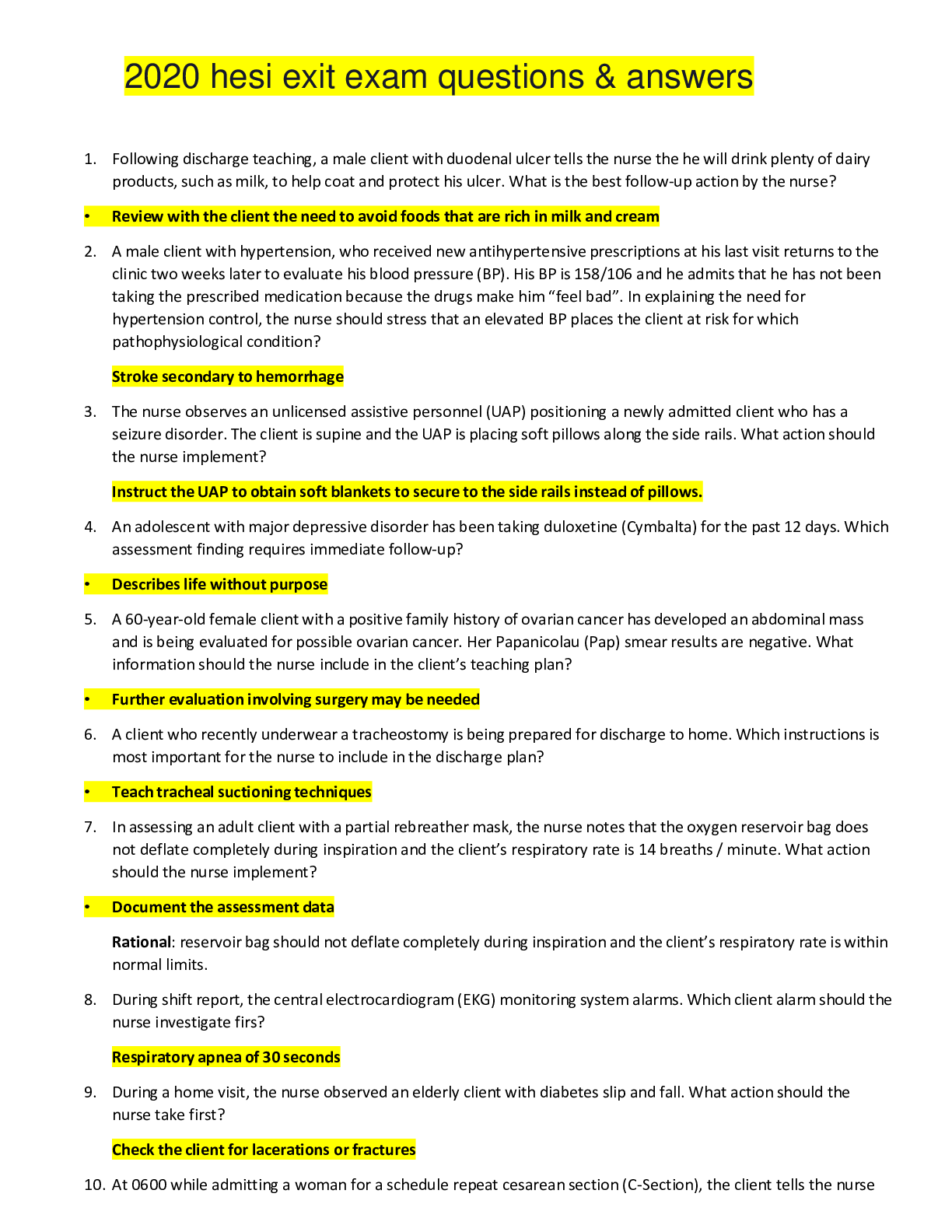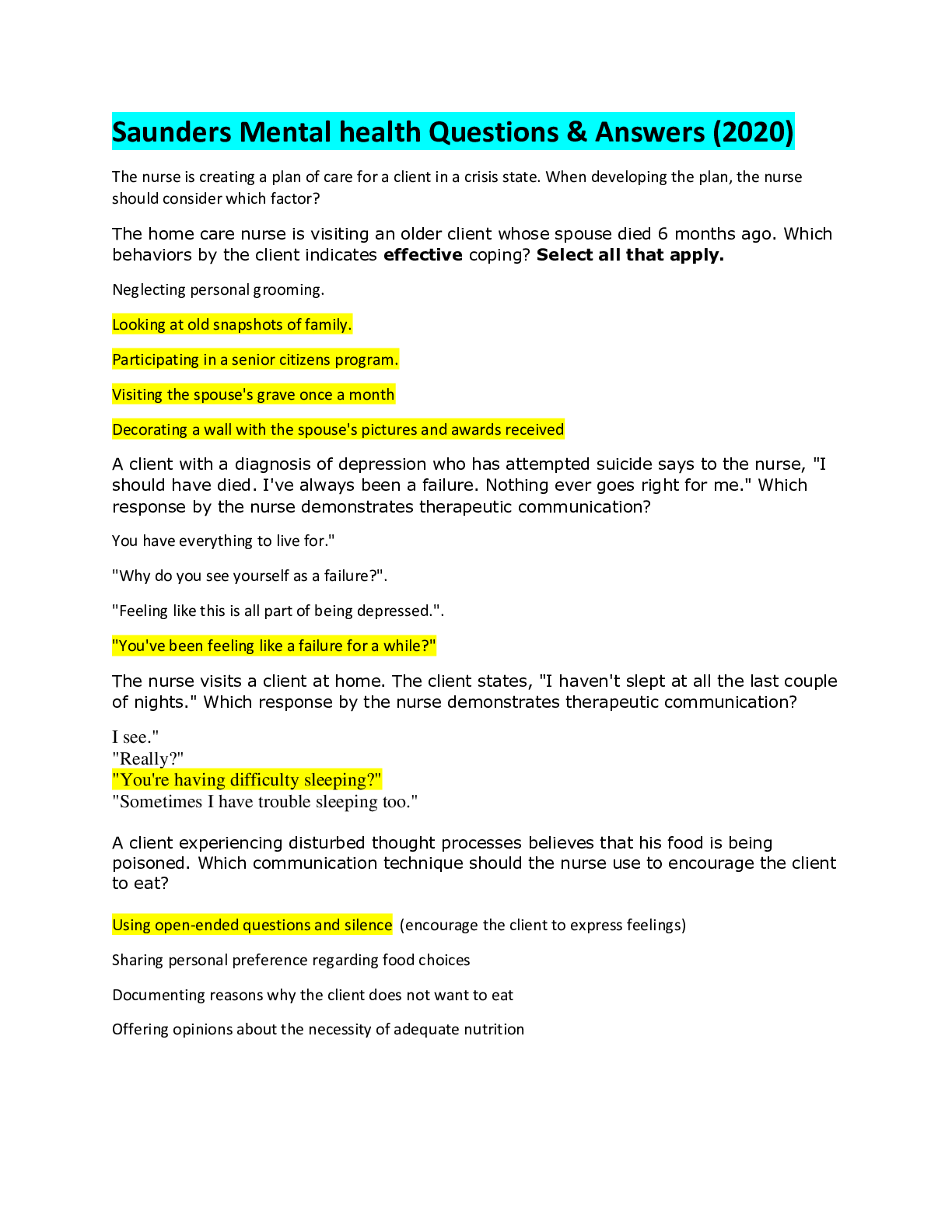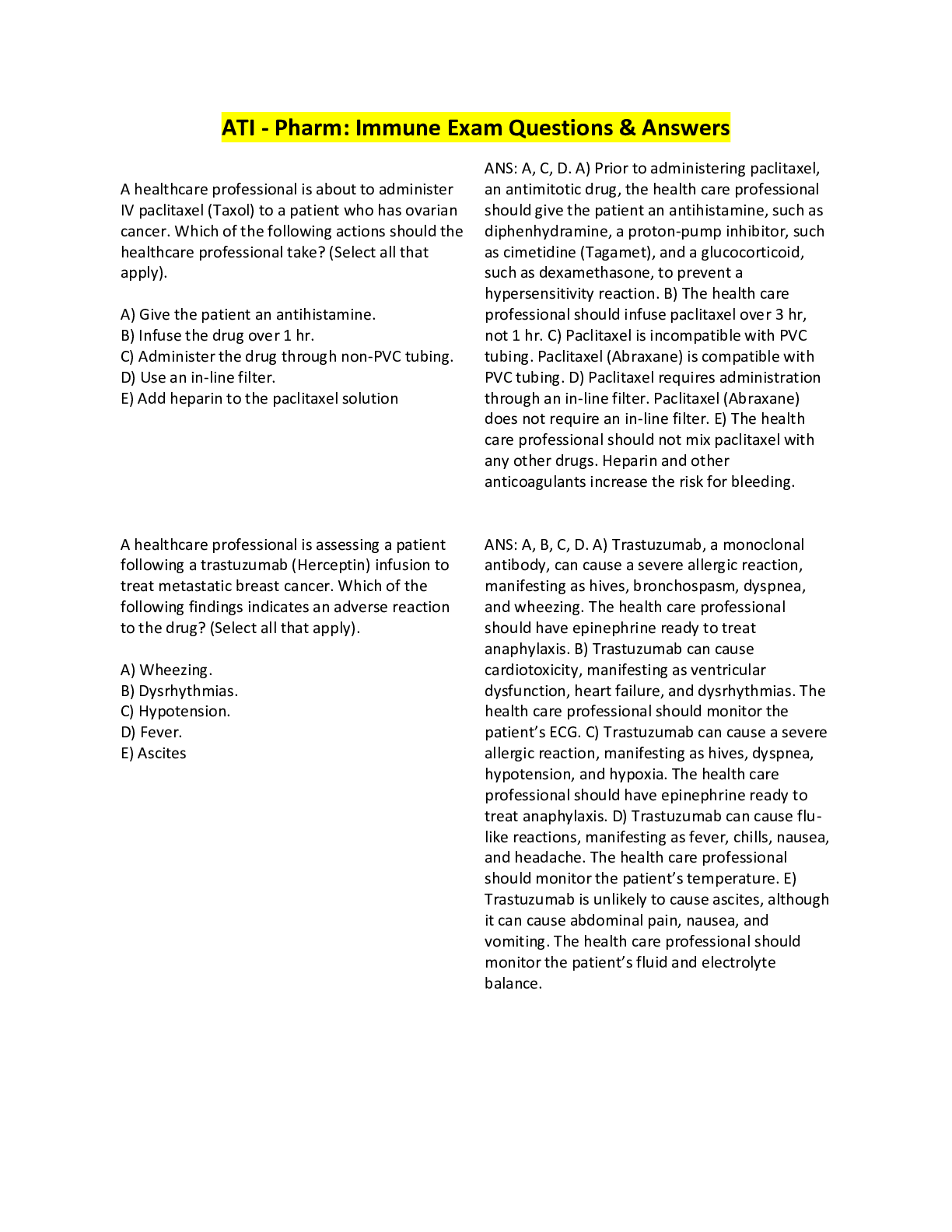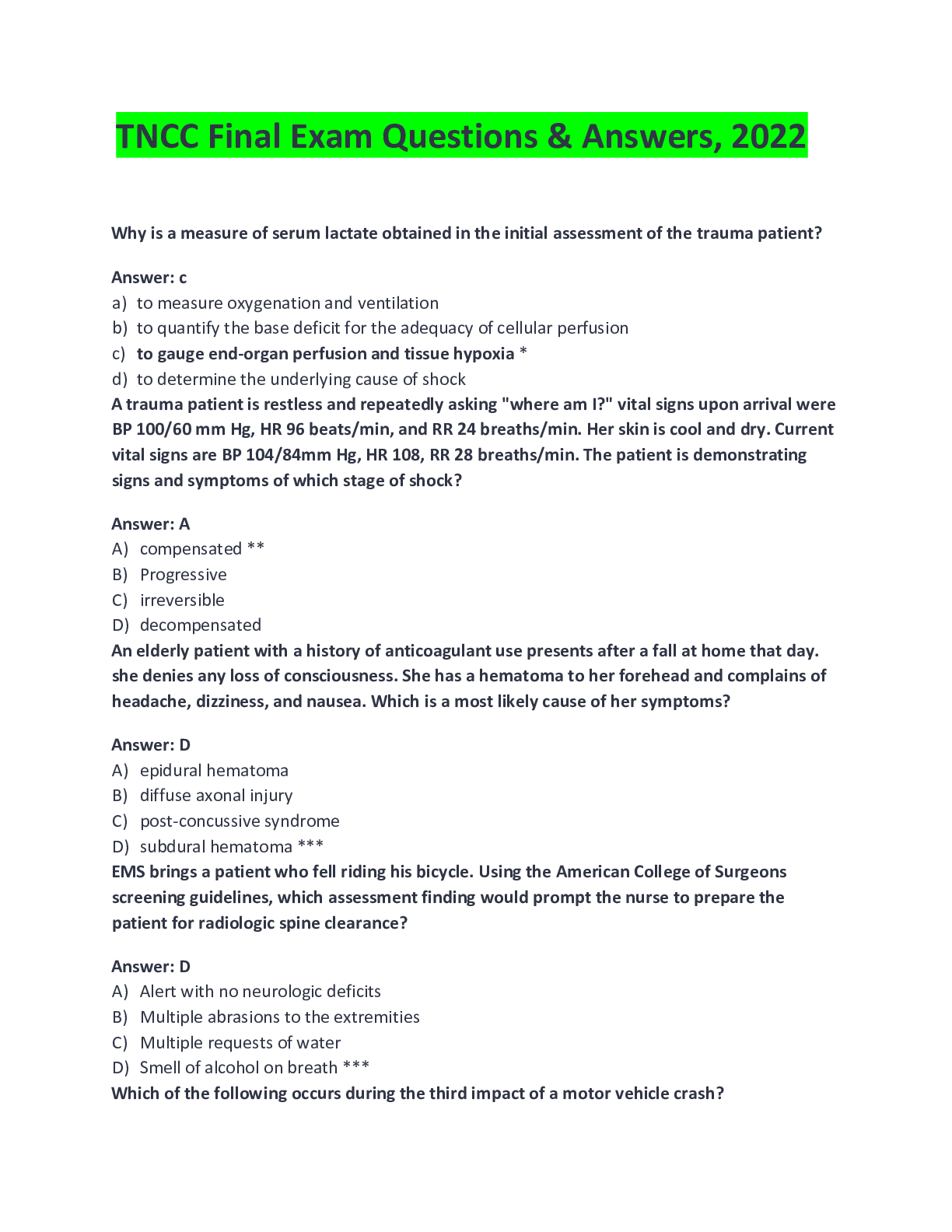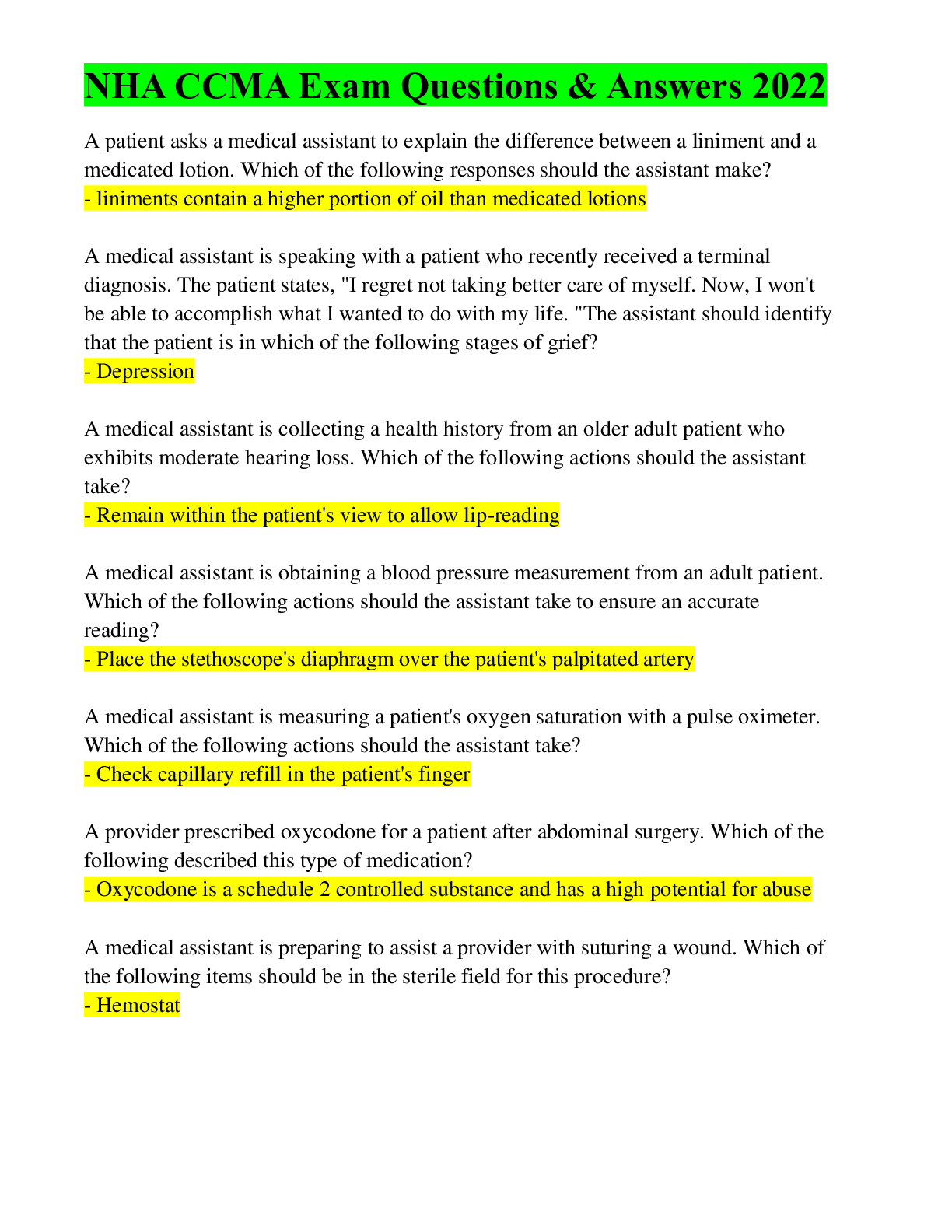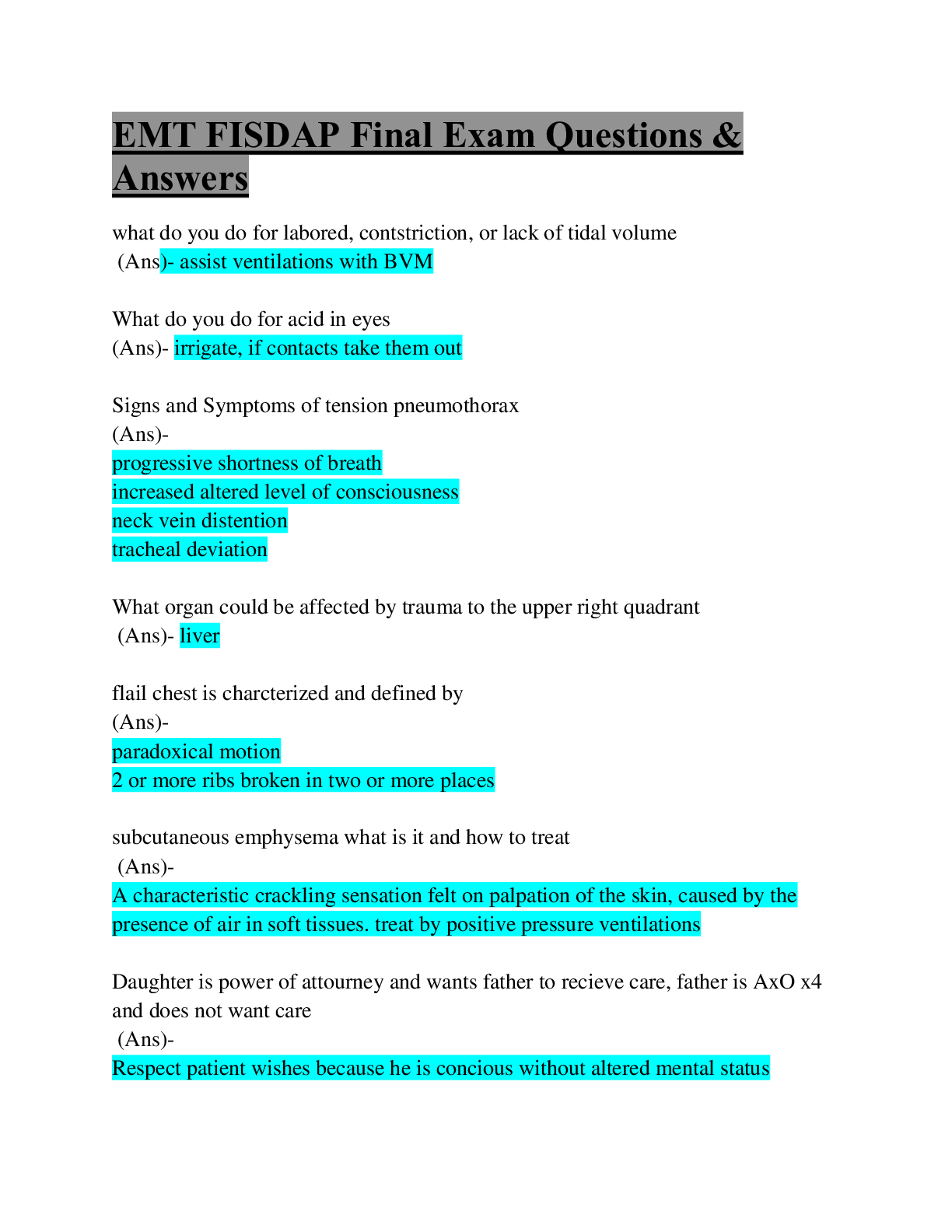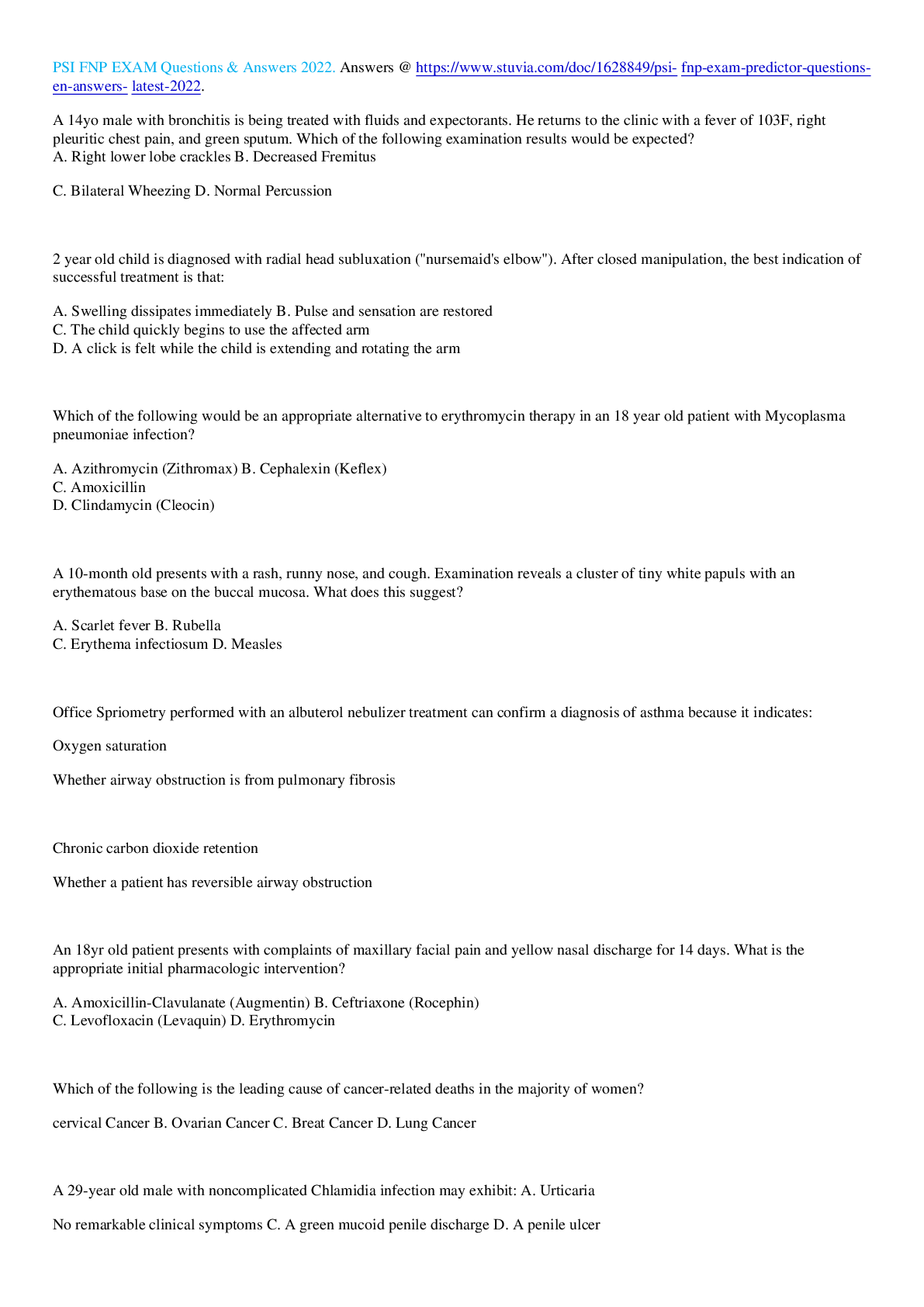*NURSING > EXAM > Acid-Base Balance Exam Questions & Answers, (Deeply Explained With Rationales) (All)
Acid-Base Balance Exam Questions & Answers, (Deeply Explained With Rationales)
Document Content and Description Below
Acid-Base Balance Exam Questions & Answers, (Deeply Explained With Rationales) -A patient had 5 liters of fluid removed during a paracentesis. What intravenous (IV) solution may be used to pull fluid ... into the intravascular space after the paracentesis? 0.9% sodium chloride 25% albumin solution Lactated Ringer's solution 5% dextrose in 0.45% saline - 25% albumin solution After a paracentesis of 5 L or greater of ascites fluid, 25% albumin solution may be used as a volume expander. Normal saline, lactated Ringer's, and 5% dextrose in 0.45% saline will not be effective for this action. A nurse reviews the arterial blood gas results of a client and notes the following: pH 7.45, Pco2 of 30, and HCO3- of 22. The nurse analyzes these results as indicating which condition? 1) Metabolic Acidosis, compensated 2) Respiratory Alkalosis, compensated 3) Metabolic Alkalosis, compensated 4) Respiratory Acidosis, compensated - Answer: 2 Rational: The normal pH is 7.3-7.45. In a respiratory condition, an opposite effect will be seen between the pH and the Pco2. In this condition, the pH is a the high end of normal and the Pco2 is low. In an alkalotic condition, the pH is elevated. Therefore the values identified in the question indicated a respiratory alkalosis. When the pH returns to a normal value, compensation has occurred. A nurse is caring for a client with a nasogastric tube that is attached to low suction. The nurse monitors the client, knowing that the client is at risk for which acid-base disorder? 1) Metabolic Acidosis 2) Metabolic Alkalosis 3) Respiratory Acidosis 4) Respiratory Alkalosis - Answer: 2 Rational: Metabolic Alkalosis is defined as a deficit or loss of hydrogen ions or acids or an excess of base (bicarbonate) that results from the accumulation of base or from a loss of acid without a comparable loss of base in the body fluids. This occurs in conditions resulting in hypovolemia, the loss of gastric fluid, excessive bicarbonate intake, the massive transfusion of whole blood, and hyperaldosteronism. Loss of gastric fluid via nasogastric suction or vomiting causes Metabolic Alkalosis as a result of the loss of hydrochloric acid. Options 1, 3, & 4 are incorrect interpretations. A client with a 3-day history of nausea and vomiting presents to the emergency department. The client is hypoventilating and has a respiratory rate of 10 breaths/min. Arterial blood gases are drawn and the nurse reviews the results, expecting to note which of the following? 1) A decreased pH and an increased CO2 2) An increased pH and a decreased Co2 3) A decreased pH and a decreased HCO3- 4) An increased pH with an increased HCO3- - Answer: 4 Rational: Clients experiencing nausea and vomiting would most likely present with metabolic alkalosis resulting from loss of gastric acid, thus causing the pH and HCO3- to increase. Symptoms experienced by the client would include hypventilation and tachycardia. Option 2 reflects a respiratory acidotic condition. Option 2 reflects a respiratory alkalotic condition. Option 3 reflects a metabolic acidotic condition. A nurse caring for a client with an ileostomy understands the the client is most at risk for developing which acid-base disorder? 1) Metabolic Acidosis 2) Metabolic Alkalosis 3) Respiratory Acidosis 4) Respiratory Alkalosis - Answer: 1 Rational: Metabolic Acidosis is defined as total concentration of buffer base that is lower than normal, with a relative increase in the hydrogen ion concentration. This results from loss of buffer bases or the retention of too many acids without sufficient bases, and occurs in conditions such as renal failure, diabetic ketoacidosis, from the production of lactic acid, from the ingestion of toxins (such as acetylsalicylic acid -aka- aspirin), malnutrition, or severe diarrhea. Intestinal secretions are high in bicarbonate and may e lost through enteric drainage tubes or an ileostomy, or with diarrhea. These conditions result in metabolic acidosis. Options 2, 3, & 4 are incorrect interpretations and do not occur in the client with an ileostomy. **(Base/Bicarbonate is lost through an ileostomy) A nurse is caring for a client with diabetic ketoacidosis and documents the the client is experiencing Kussmaul's respirations. Based on this documentation, which of the following did the nurse observe? 1) Respirations that cease for several seconds 2) Respirations that are regular but abnormally slow 3) Respirations that are labored and increased in depth and rate 4) Respirations that are abnormally deep, regular, and increased in rate - Answer: 4 Rational: Kussmal's respirations are abnormally deep, regular, and increased in rate. Apnea is described as repirations that cease for several seconds. In bradypnea, respirations are regular but abnormally slow. In hyperpnea, respirations are labored and increased in depth and rate. A client who is found unresponsive has arterial blood gases drawn and the results indicate dthe following: pH is 7.12, Pco2 is 90, and HCO3- is 22. the nurse interprets the results as indicating which condition? 1) Metabolic Acidosis with compensation 2) Respiratory Acidosis with compensation 3) Metabolic Acidosis without compensation 4) Respiratory Acidosis without compensation - Answer: 4 Rational: The acid-base disturbance is respiratory acidosis without compensation. The normal pH is 7.35-7.45. The normal Pco2 is 32-48. In respiratory acidosis the pH is decreased and the pco2 is elevated. The normal bicarbonate (HCO3-) level is 22-27. Because the bicarbonate is still within normal limits, the kidneys have not had time to adjust for this acid-base disturbance. Additionally, the pH is not within normal limits. Therefore the condition is without compensation. Options 1, 2, & 3 are incorrect interpretations. The nurse plans care for a client with chronic obstructive pulmonary disease (COPD), understanding that the client is most likely to experience what type of acid-bases imbalance: 1) Metabolic Acidosis 2) Metabolic Alkalosis 3) Respiratory Acidosis 4) Respiratory Alkalosis - Answer: 3 Rational: Respiratory Acidosis is most often caused by hypoventilation in a client with COPD. Other acid-base disturbances can occur in a client with COPD during exacerbation of the disease but the most likely imabalance is respiratory acidosis. Option 1, 2,& 4 are incorrect options. A nurse reviews the blood gas results of a client with atelectasis. The nurse analyzes the results and determines that the client is experiencing respiratory acidosis. Which of the following validates the nurse's findings? 1) pH 7.25, Pco2 50, 2) pH 7.35, Pco2 40 3) pH 7.50, Pco2 52 4) pH 7.52, Pco2 28 - Answer: 1 Rational: Atelectasis is a condition characterized by the collapse of alveoli, preventing the respiratory exchange of oxygen and carbon dioxide in a part of the lungs. The normal pH is 7.35-7.45. The normal Pco2 is 32-48. In respiratory acidosis, the pH is decreased and the Pco2 is elevated. Option 2 identifies normal values. Option 3 identifies an alkalotic condition. Option 4 identifies respiratory alkalosis. A nurse is caring for a client who is on a mechanical ventilator. Blood gas results indicated a pH of 7.50 and a Pco2 of 30. The nurse has determines that the client is experience respiratory alkalosis. Which laboratory value would most likely be noted in this condition? 1) Sodium level of 145 2) Potassium level of 3 3) Magnesium level of 2 4) Phosphorus level of 4 - Answer: 2 Rational: Respiratory alkalosis is defined as a deficit of carbonic acid or a decrease in hydrogen ion concentrations that results from the accumulations of base or from a loss of acid without a comparable loss of base in the body fluids. This occurs in conditions that cause overstimulation of the respiratory system. Clinical manifestations of repiratory alkalosis include headache, tachypnea, paresthesias, tetany, vertigo, convusions, hypkalemia, and hypocalcemia. Options 1, 3, & 4 identify normal laboratory values. Option 2 identifies the presence of hypokalemia. A nurse notes that a client's arterial blood gas reults reveal a pH of 7.50 and a Pco2 of 30. The nurse monitors the client for which clinical manifestations associated with these arterial blood gas results? Select all the apply: 1) Nausea 2) Confusion 3) Bradypnea 4) Tachycardia 5) Hyperkalemia 6) Lightheadedness - Answer: 1, 2, 4, 6 Rational: Respiratory alkalosis is defined as a deficit of carbonic acid or a decrease in hydrogen ion concentrations that results from the accumulations of base or from a loss of acid without a comparable loss of base in the body fluids. This occurs in conditions that cause overstimulation of the respiratory system. Clinical manifestations of repirtory alkalosis include lethargy, lightheadedness, confusion, tachycardia, dysrhythmias related to hypokalemai, nausea, vomiting, epigastric pain, and numbness and tingling of the extremities. Hyperventilation (tachypnea) occurs. The nurse is caring for a patient admitted with a diagnosis of chronic obstructive pulmonary disease (COPD) who has the following arterial blood gas results: pH 7.33, PaO2 47 mm Hg, PaCO2 60 mm Hg, HCO3 32 mEq/L, and O2 saturation of 92%. What is the correct interpretation of these results? 1. Fully compensated respiratory alkalosis 2. Partially compensated respiratory acidosis 3. Normal acid-base balance with hypoxemia 4. Normal acid-base balance with hypercapnia - 2. Partially compensated respiratory acidosis A low pH (normal 7.35-7.45) indicates acidosis. In the patient with a respiratory disease such as COPD, the patient retains carbon dioxide (normal 35-45 mm Hg), which acts as an acid in the body. For this reason, the patient has respiratory acidosis. The elevated HCO3 indicates a partial compensation for the elevated CO2. The nurse provides care for a patient with respiratory alkalosis. What arterial blood gas results correspond to this condition? 1. pH 7.46, pCO2 44 mm Hg, PO2 95 mm Hg, and HCO3- 36 mEq/L 2. pH 7.27, pCO2 70 mm Hg, PO2 80 mm Hg, and HCO3- 26 mEq/L 3. pH 7.30, pCO2 35 mm Hg, PO2 70 mm Hg, and HCO3- 20 mEq/L 4. pH 7.52, pCO2 24 mm Hg, PO2 85 mm Hg, and HCO3- 24 mEq/L - 4. pH 7.52, pCO2 24 mm Hg, PO2 85 mm Hg, and HCO3- 24 mEq/L The patient is experiencing alkalosis because the pH is greater than 7.45. The alkalosis is of a respiratory origin because the carbon dioxide is below normal (reflecting that there is not enough acid) and the HCO3- is within normal range. Normal arterial blood gas values include pH 7.35 to 7.45, pCO2 35 to 45, HCO3- 22 to 26. A pH of 7.46, pCO2 of 44 mm Hg, pO2 of 95 mm Hg, and HCO3- of 36 mEq/L indicate metabolic alkalosis, because pH is increased, the pCO2 is normal, and the HCO3- is increased. A pH of 7.27, pCO2 of 70 mm Hg, pO2 of 80 mm Hg, and HCO3- of 26 mEq/L indicate respiratory acidosis, because pH is low, pCO2 is increased, and HCO3- is normal. A pH of 7.30, pCO2 of 35 mm Hg, pO2 of 70 mm Hg, and HCO3- of 20 mEq/L indicate metabolic acidosis, because the pH is low, pCO2 is normal, and HCO3- is low. The nurse is caring for a patient admitted with an exacerbation of asthma. After several treatments, the arterial blood gas (ABG) results are pH 7.40, PaCO2 40 mm Hg, HCO3 24 mEq/L, PaO2 92 mm Hg, and O2 saturation 99%. The nurse interprets these results as 1. Within normal limits 2. Slight metabolic acidosis 3. Slight respiratory acidosis 4. Slight respiratory alkalosis - 1. Within normal limits The normal pH is 7.35 to 7.45. Normal PaCO2 levels are 35 to 45 mm Hg and normal HCO3 leverls are 22 to 26 mEq/L. A normal PaO2 level is >80 mm Hg. Normal oxygen saturation is >95%. Because the patient's results all fall within these normal ranges, the nurse can conclude that the patient's blood gas results are within normal limits. A patient's arterial blood gas results are: pH 7.48, PaCO2 38, HCO3- 30. The patient is in: 1. Metabolic acidosis 2. Metabolic alkalosis 3. Respiratory acidosis 4. Respiratory alkalosis - 2. Metabolic alkalosis Normal pH is 7.35-7.45. Values greater than 7.45 indicate alkalosis. Normal value for HCO3- is 22-26 mEq/L. Because the PaCO2 is normal and the HCO3- is elevated, the source of the alkalosis is metabolic. The patient is in metabolic alkalosis. Which condition does the nurse suspect in a patient with renal failure? 1 Metabolic acidosis 2 Metabolic alkalosis 3 Respiratory acidosis 4 Respiratory alkalosis - 1 Renal failure will make the blood more acidic because of the inability of the kidneys to excrete acid. Therefore, the nurse suspects that the patient would develop metabolic acidosis. Metabolic alkalosis is caused by excess bicarbonate intake and a potassium deficit. Respiratory acidosis is caused by hypoventilation. Respiratory alkalosis is caused by hyperventilation. After reviewing the patient's arterial blood gas analysis report, the primary health care provider concludes that the patient has respiratory acidosis. Which findings made the primary health care provider reach this conclusion? 1 pH, 7.4, partial pressure of carbon dioxide (PaCO2), 44, bicarbonate ion (HCO3-), 26 2 pH, 7.2, partial pressure of carbon dioxide (PaCO2), 47, bicarbonate ion (HCO3-), 25 3 pH, 7.36, partial pressure of carbon dioxide (PaCO2), 41, bicarbonate ion (HCO3-), 23 4 pH, 7.42, partial pressure of carbon dioxide (PaCO2), 42, bicarbonate ion (HCO3-), 24 - Which value of partial pressure of carbon dioxide (PaCO2) in arterial blood indicates a compensatory response in metabolic alkalosis? 1 38 mm Hg 2 40 mm Hg 3 44 mm Hg 4 47 mm Hg - 4 Metabolic alkalosis results in decreased carbonic acid. Therefore, to increase its concentration, the respiratory rate is reduced. This reduction leads to a rise in carbon dioxide concentration in the blood. Normal values of partial pressure of carbon dioxide (PaCO2) range from 35 to 45 mm Hg; 47 mm Hg of PaCO2 indicates a compensatory response in metabolic alkalosis. A patient's arterial blood gas results are: pH 7.32; PaCO2 52; HCO3- 24. The patient is in: 1 Metabolic acidosis 2 Metabolic alkalosis 3 Respiratory acidosis 4 Respiratory alkalosis - 3 Normal pH is 7.35 to 7.45. Values less than 7.35 indicate acidosis. Normal value for PaCO2 is 35 to 45 mm Hg. Because the HCO3- is normal and the PaCO2 is elevated, the source of the acidosis is respiratory. The patient is in respiratory acidosis. What is the function of a buffer? 1 To excrete weak acids 2 To secrete hydrogen ions 3 To convert strong acids to weak acids 4 To convert ammonia to ammonium ions - 3 Buffers convert strong acids to weak acids. Excretion of weak acids, secretion of hydrogen ions into the renal tubule, and conversion of ammonia to ammonium ions takes place in the kidneys. What is the normal range of blood pH? 1 7.05 to 7.15 2 7.15 to 7.25 3 7.25 to 7.35 4 7.35 to 7.45 - The normal range of blood pH is 7.35 to 7.45. A pH less than 7.35 indicates acidosis. Which value of blood pH indicates acidosis? 1 7.25 2 7.35 3 7.45 4 7.55 - 1 A pH below 7.35 indicates acidosis; thus a pH of 7.25 a sign of acidosis. Normal blood pH lies between 7.35 and 7.45. A pH of 7.55 indicates alkalosis. A patient has the following arterial blood gas results: pH 7.32; PaCO2 56 mm Hg; HCO3- 24 mEq/L. The nurse determines that these results indicate: 1 Metabolic acidosis 2 Metabolic alkalosis 3 Respiratory acidosis 4 Respiratory alkalosis - 3 Respiratory acidosis (carbonic acid excess) occurs whenever a person experiences hypoventilation. Hypoventilation leads to a buildup of CO2, resulting in an accumulation of carbonic acid in the blood. Carbonic acid dissociates, liberating H+, and there is a decrease in pH. The patient is not experiencing metabolic acidosis. These results are not indicative of metabolic alkalosis or respiratory alkalosis (because the pH is high). A diabetic patient fasting before surgery reports feeling dizzy and deep rapid breathing. A nurse observes that the patient has developed Kussmaul respirations. What condition is the patient most likely experiencing? 1 Metabolic acidosis 2 Metabolic alkalosis 3 Respiratory acidosis 4 Respiratory alkalosis - 1 The patient has been fasting and complains of dizziness. The patient has likely developed diabetic ketoacidosis, a type of metabolic acidosis. Kussmaul respiration is deep, rapid breathing that develops in response to metabolic acidosis. This type of breathing is a compensatory mechanism to excrete excess carbon dioxide from the lungs. Metabolic alkalosis occurs when there is a loss of acid or a gain in bicarbonate. It is not associated with Kussmaul respiration. Respiratory acidosis results when the person hypoventilates and carbonic acid accumulates in the blood. Respiratory alkalosis occurs when the person hyperventilates. [Show More]
Last updated: 1 year ago
Preview 1 out of 53 pages

Reviews( 0 )
Document information
Connected school, study & course
About the document
Uploaded On
Aug 03, 2022
Number of pages
53
Written in
Additional information
This document has been written for:
Uploaded
Aug 03, 2022
Downloads
0
Views
70







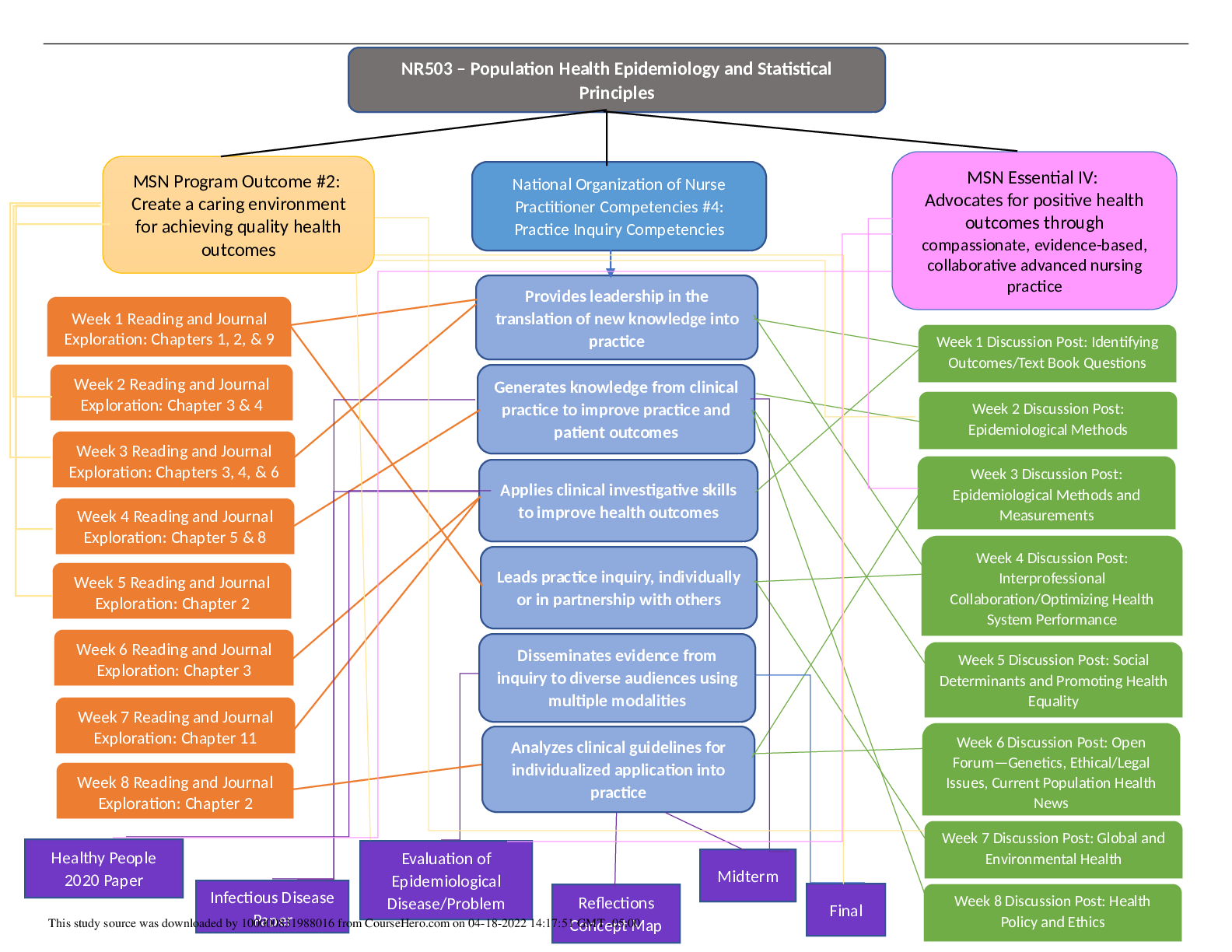

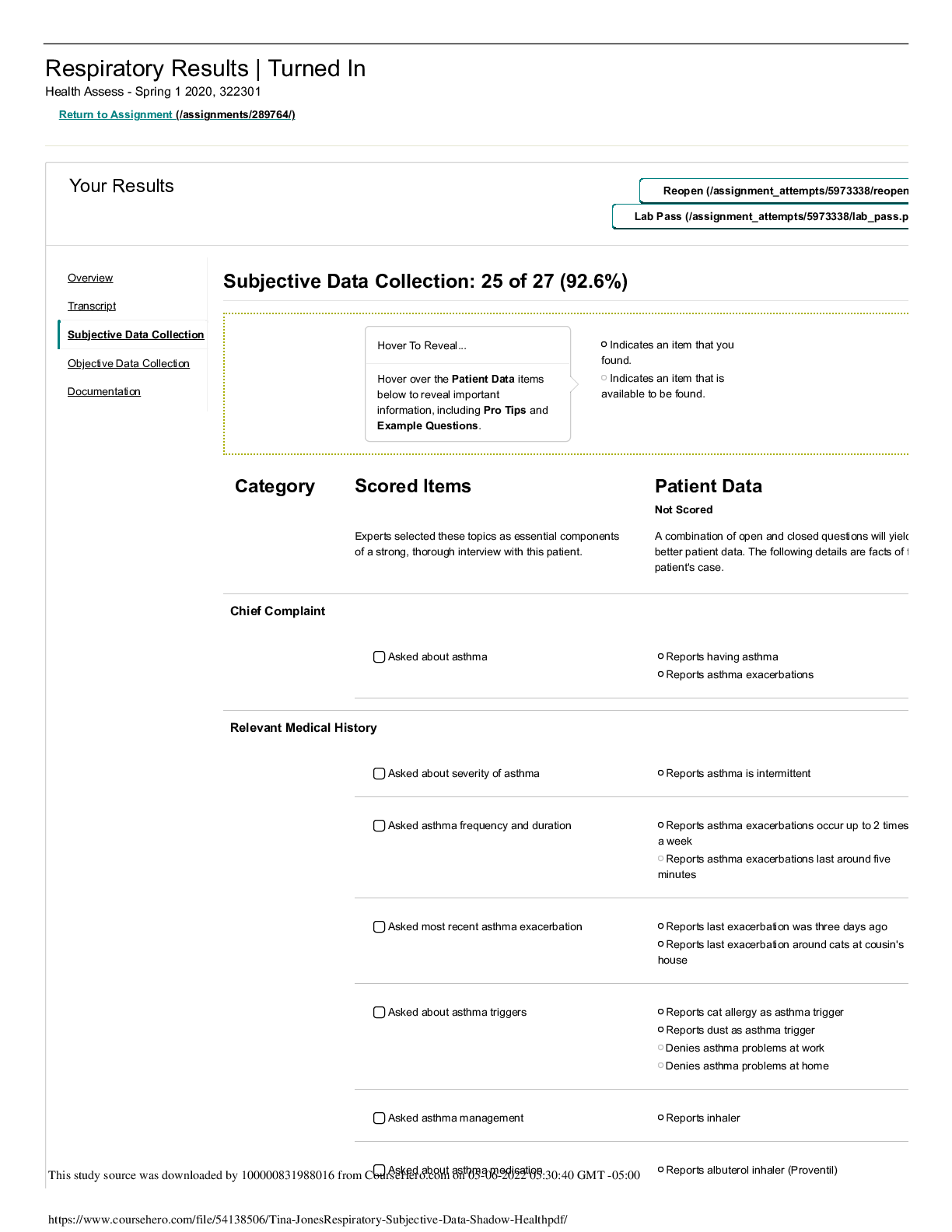
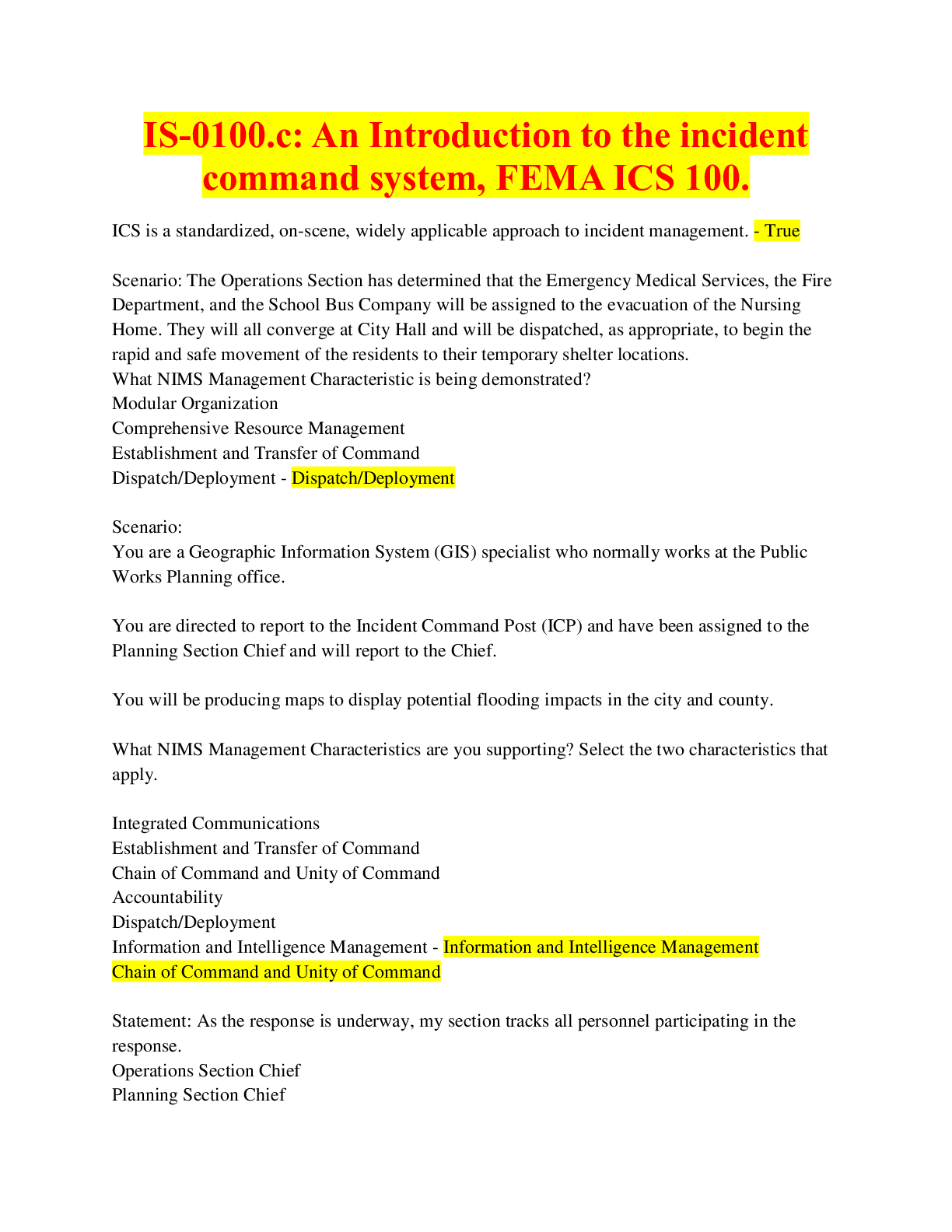



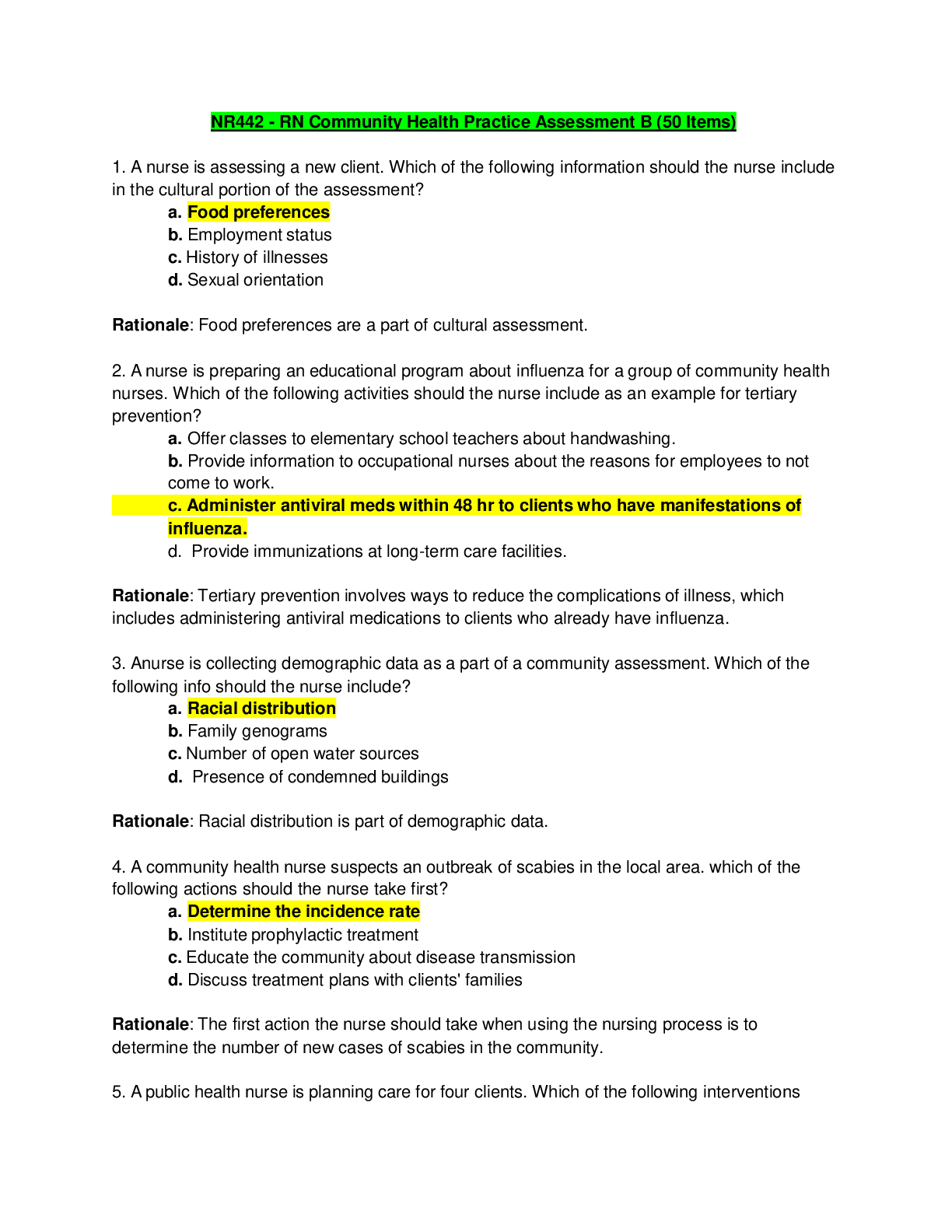


.png)


